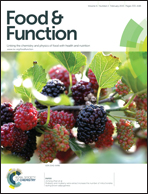Lutein derived fragments exhibit higher antioxidant and anti-inflammatory properties than lutein in lipopolysaccharide induced inflammation in rats
Abstract
In the present study, we appraise the anti-inflammatory efficacy of lutein oxidative degradation derivatives mediated through UV-irradiation over lutein in counteracting the inflammation induced by lipopolysaccharide (LPS) in rats (n = 5 per group). UV-irradiated lutein fragments were identified as anhydrolutein (B, C40H54O), 2,6,6-trimethylcyclohexa-1,4-dienylium (M1, C9H13), (2E,4E,6E,8E)-9-(4-hydroxy-2,6,6-trimethylcyclohex-1-1en-1-yl)-3,7-dimethylnona-2,4,6,8-tetraen-1-ylium (M2, C20H29O), 4-[(1E,3E,5E,7E)-3,7,-dimethyldeca-1,3,5,7-tetraen-1-yl]-3,5,5-methylcyclohex-3-en-1-ol (M3, C21H30O) and zeaxanthin (M4, C40H56O) and its isomers as 13′-Z zeaxanthin, 13′-Z lutein, all-trans zeaxanthin, and 9-Z lutein. Induction of inflammation by LPS significantly increased the production of nitrites (3.3 fold in the serum and 2.6 fold in the liver), prostaglandin E2 (26 fold in the serum), and pro-inflammatory cytokines like tumor necrosis factor-α (6.6 fold in the serum), and interleukin-6 (4.8 fold in the serum). Oxidative derivatives of lutein, especially M1, M2 and M3, ameliorated acute inflammation in rats by inhibiting the production of nitrites, malondialdehyde (MDA), PGE2, TNF-α, and IL-6 cytokines more efficiently than lutein in rats. The anti-inflammatory mechanism of derivatives might be related to the decrease of inflammatory cytokines and the increase of antioxidant enzymes (superoxide dismutase, catalase, glutathione peroxidase, glutathione S transferase, glutathione reductase), which would result in the reduction of iNOS, COX-2 and MDA and subsequently inflammatory responses.


 Please wait while we load your content...
Please wait while we load your content...